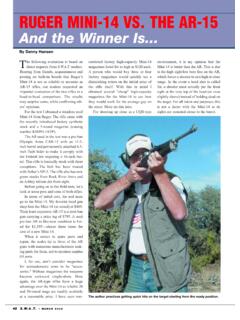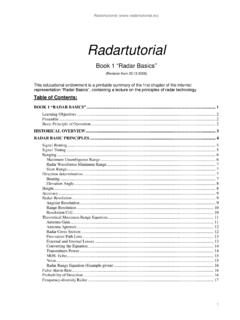Transcription of CHAPTER 5 ELECTROMAGNETIC PULSE (EMP) PROTECTION
1 TM 5-690 5-1 CHAPTER 5 ELECTROMAGNETIC PULSE (EMP) PROTECTION 5-1. Purpose of EMP PROTECTION The purpose of the ELECTROMAGNETIC PULSE (EMP) PROTECTION system is to protect critical electrical systems from the effect of intense ELECTROMAGNETIC (EM) effects caused as a result of an explosion. The frequency spectrum may extend from below 1 Hz to above 300 MHz. The high-altitude EMP produced by an exoatmospheric nuclear explosion is the form of EMP commonly of most interest because of the large area covered by a single bomb. This high-intensity EMP can disrupt or damage critical electronic facilities over an area as large as the continental United States, unless protective measures are taken in the facilities. The development of such protective measures involves grounding, bonding, and shielding.
2 5-2. Types of EMP An EMP event can be subdivided into three time-based periods, each of which has distinct characteristics. a. Early time EMP. During the early time portion of the EMP the amplitude, duration, and polarization of the wave depend on the positions of the burst and the observer, relative to the Earth s magnetic field lines. Peak electric field strengths of over 50 kV/m with risetimes of a few nanoseconds and decay times of less than 1 s are typical. b. Late time EMP. During the late time portion of the EMP, currents are induced in the ground by the effects of the expanding and rising fireball constituents. These effects are called the magnetohydrodynamic EMP. As a result the currents produced induce image currents in the ground over a period of 10 to 100 seconds.
3 Although the field strengths produced at the surface by the magnetohydrodynamic EMP are small (tens of volts per kilometer), they occur over long times. Thus, the magnetohydrodynamic EMP is a consideration for long power and communications lines and, because of its duration, for the energy it can deliver to protective devices. c. Intermediate time EMP. Between the early-time EMP and the magnetohydrodynamic EMP, transitory phenomena produce what is called intermediate-time EMP. This EMP lasts from about 1 s to about s. The intermediate-time EMP observed at the Earth s surface has a peak electric field strength of a few hundred volts per meter and is predominantly vertically polarized. d. Surface burst EMP. When a nuclear weapon is detonated at or near the surface of the Earth, neutrons and gamma rays are ejected radially outward from the burst center.
4 The surface-burst EMP is a more localized source than the EMP and the event may cause large currents to be induced on long conductors, such as power lines and communication cables. These currents may be propagated along the conductors for great distances from their source. Therefore, this source-region EMP may be important to systems far outside the source region if they are connected to the source region through wires, cables, or other conductors. e. High altitude EMP. The high-altitude EMP is the most important form of EMP for communication facilities because of its large area of coverage. However, in addition to the EMP and the surface-burst EMP, a few other electrical effects could occur. System-generated EMP is produced when the high-TM 5-690 5-2 energy particles (mostly gamma- and X-ray photons) produced by the bomb interact directly with the system structure.
5 These interactions knock electrons out of the structure, which causes current on the structure and potential gradients between the structure and the removed electrons. The structure of interest may be system wiring or cable shielding; the current and potential differences are then on system circuits. 5-3. Effects of EMP on facility systems EMP interaction with systems may be separated into long-line effects and local effects. Long-line effects are the currents and voltages induced on long power lines, communication cable links, or even other conductors, such as pipelines. Some of these EMP effects may be induced far away and guided to the facility along the conductor. Local effects are the currents and voltages induced directly on the facility shield, building structure, wiring, equipment cabinets, etc.
6 These local effects are very difficult to evaluate analytically because of the complexity of the facility structure, the lack of information on the broadband electrical properties of many of the structural materials, and the extremely large number of interaction paths, facility states, and other complicating factors. On the other hand, the local interactions can be evaluated experimentally with simulated EMP fields that envelop the facility. a. EMP induced currents. The currents induced on long straight overhead lines parallel to the Earth s surface by EMP-like events have been analyzed thoroughly. If the line is over a perfectly conducting ground plane, the current has a waveform similar to the EMP early-time waveform, except for a slightly longer risetime for lines more than a few feet high.
7 For imperfectly conducting ground, such as soil, the imperfect reflection of the wave from the ground allows the line to be driven more strongly and for a longer time than if the ground were a good conductor. b. Effects on long buried lines. In long buried lines imperfectly conducting soil does not completely reflect the incident field; some of the incident wave is transmitted into the soil. This field in the soil can induce current in underground cables, pipes, and other conductors. However, because the velocity of propagation of a wave is much less in soil than in air, the bow-wave effect is almost negligible on buried conductors. Furthermore, the attenuation on buried conductors is greater than on overhead lines because of the proximity of the soil to the buried conductor.
8 C. Effects on conductors in contact with the soil. For conductors in contact with the soil (i. e., buried bare conductor), the current at any observation point is determined primarily by coupling within one skin-depth of the observation point. Current induced at points farther away is so strongly attenuated by the soil that it adds little to the total current at the observation point. d. Effects on vertical structures. The EMP interacts with vertical structures, such as radio towers, waveguides, and cables to overhead antennas, and downleads from power and communication lines in much the same manner as it interacts with horizontal lines, except that it is the vertical component of the electric field that drives the vertical structures. e.
9 Effects on closed shields. The EMP fields incident on a closed shield induces surface currents and charge displacements on the outer surfaces of the shield. If the shield is continuous metal (i. e., it has no opening or discontinuities in its surface) and about 1 mm thick, voltage is induced in circuits inside the shield by these surface currents. f. Effects on insulated penetrating conductors. Conductors, such as power and signal wires, that pass through the shield may allow very large currents and voltages to be delivered to internal circuits. The current on the wire just inside the shield is about equal to the current just outside the shield; the wire is a hole in the shield or, in other words, a 0 decibel (dB) compromise of the shield. A major concern for TM 5-690 5-3 EMP interaction is the penetrating conductor that can guide EMP-induced waves through shield walls.
10 The shield is effective in excluding the incident EM waves , but it has little effect on the waves guided through it on insulated penetrating conductors. g. Effects on apertures in shield surfaces. Apertures in the shield surface allow the external EMP-induced fields to penetrate through the shield and interact with internal wiring or other conductors. The external electric field associated with the surface charge density can induce charge on internal cables. The external magnetic, field which has the same magnitude as the surface current density can penetrate through the aperture to link internal circuits. h. Transient radiation effects on electronics (TREE). Another important electrical effect is known as transient radiation effects on electronics (TREE).







